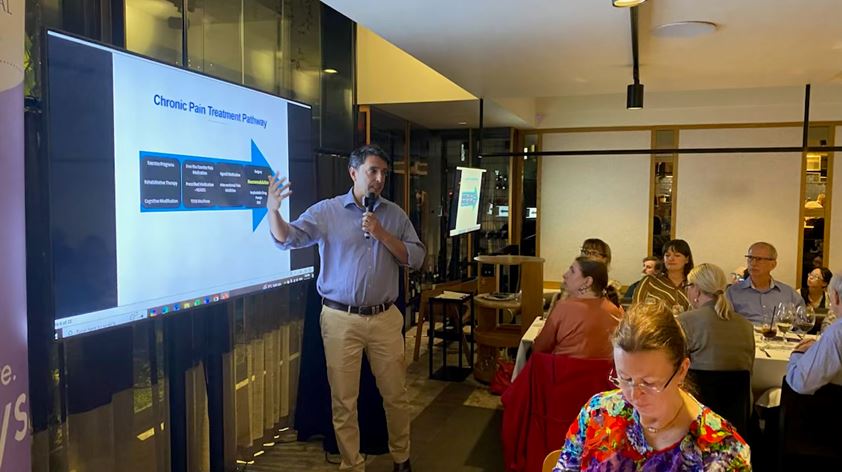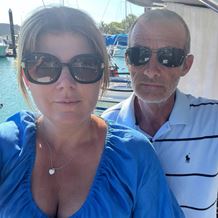Ashley’s pain journey from a bomb blast in Afghanistan to swimming the English Channel!
St Vincent's Private Hospital Brisbane
It was the month that changed former Navy clearance diver and Explosive Ordnance Disposal expert Ashley Semmen’s life forever and in every conceivable way.
It involved two unbelievably close brushes with death in Afghanistan – one where he literally dodged a bullet (from a Taliban sniper) and the other where he survived a bomb blast; as well as the loss of a close Army colleague who was killed while on active duty; and then the bitter-sweet moment of seeing his first and only son being born (an event that he witnessed via phone from an outpost in the war zone.)
Even though his natural habitat was the water as a Navy clearance diver (he was a specialist full-time diver and bomb disposal expert) AB (Able Seaman) Semmens was seconded to a tour of Afghanistan in 2012 due to a shortage of land-based Explosive Ordnance Disposal experts.
The bomb blast just three months into his tour of duty – where the Australian Bushmaster vehicle he was travelling in was destroyed by a Taliban roadside bomb or IED (Improvised Explosive Device) – left him with a serious and debilitating back injury and more than a decade of chronic pain. It contributed to him eventually being medically discharged from the Australian Defence Force.


“We were all incredibly lucky, although it says something about the quality of the Bushmaster vehicles that it could save us from a major bomb blast.
The structure withstood much of the blast although the wheels got blown off. I was in the rear of the vehicle. We all suffered serious injuries although it could have been a whole lot worse,” says Ashley.
“For me, I had damaged and bulging discs (later diagnosed as lumbar spondylosis) although it was undiagnosed at the time. I had a few days laying low at our base at Tarin Kowt (in southern Afghanistan) after the IED incident, but then you were expected to get back to work – plus you also didn’t want to let your team down.”
More than one in five Australians live with some form of chronic or regular pain.
While there are several definitions, chronic pain can be described as persistent pain which lasts more than three months and which can be triggered by a multitude of factors. For Ashley, his chronic pain lasted over a decade and he willingly admits that he managed the pain by either ignoring it or self-medicating with alcohol and prescription painkillers.
“I was concerned that at that stage of the Defence Force culture relating to psychological damage and injuries from over 15 years of service, that if I opened up to one of my superiors about my struggles, it would have been the end of my career,” says Ashley, now aged 40.
Ashley continued to serve his country in a range of roles, including later in the Human Intelligence Branch, as an Interrogator & Interrogation manager, before finally putting his hand up in 2021 and telling his Commanding Officer that he was struggling with his mental health (including contemplating suicide). He was diagnosed with depression and Post Traumatic Stress Disorder (PTSD) in 2021 and was medically discharged from the ADF in 2022, not long after being promoted to the rank of Chief Petty Officer.
Following his discharge, and still wracked by chronic back pain, Ashley was referred to Dr Ramsey Jabbour.
A specialist pain medicine physician with St Vincent’s Private Hospital Northside, for his back injury, Dr Jabbour recommended a graduated approach to treating his chronic pain starting with one of the less invasive interventional pain procedures, radiofrequency ablation (also called radiofrequency neurotomy) of pain nerves in his vertebrae.
Radiofrequency ablation procedure uses specialised equipment to target some forms of nerve pain and nerves that supply feeling to joints. It involves a specialist pain medicine physician carefully placing needles close to nerves which are sending the pain signals, and uses heat produced at the tip of the needle and directed at the nerves. This procedure interrupts the nerves from sending signals to the brain, which can provide long-lasting pain reduction (on average from nine – twelve months).

Dr Ramsey Jabbour
“I was in and out of St Vincent’s Hospital in a day for the treatment by Dr Jabbour. Before the procedure – on my bad days, I was basically bed-bound and the pain was around 9 out of 10. But the day after the procedure the pain was dramatically reduced to around 2 out of 10 and it has stayed there pretty much since then and means I’ve been able to get on with my life,” says Ashley.
Dr Jabbour says his approach is to match the right patient for the right treatment – which in a majority of cases means that people can have very good outcomes over an extended period of time.
“Using a range of treatment options, we can get really good results in certain people – 80% of people will get 50% or more pain relief for 9-24 months and sometimes they gain more pain relief and for much longer,” says Dr Jabbour.
“With Ashley’s treatment of radiofrequency ablation, it was a targeted approach – we were targeting sensory nerves whether they’re nerves supplying the disc (or in other cases supplying a limb or supplying joints.) We are trying to modulate the nerve itself or stop the nerve from working by ablating it (deadening or stunning the nerves with heat) and we expect that patients will get 50% or more pain relief.
“When it’s complemented with holistic management – such as physiotherapy and appropriate strengthening activities – it can help people to return to a good quality of life and provide functional improvement.”

Last week, St Vincent’s hosted a special event for GPs, a symposium to help expand their knowledge and understanding in “separating fact from fiction” in helping patients to manage chronic pain and to raise awareness of the range of treatment options.
Dr Michelle O’Brien is a specialist pain medicine physician and anaesthetist who works at St Vincent’s Private Hospital Brisbane, while also serving as President of the Neuromodulation Society of Australia and New Zealand.
Dr O’Brien says: “There are many reasons why people experience chronic pain - and pain management can help with all of these. Any part of the body can be affected by chronic pain and there are many different approaches that can be used.
“Pain can inhibit or impact on everyday function from the ability to work to full capacity and functionality, right through to completing normal everyday household tasks, physical activity and social engagement that we all take for granted.
“Patients who have had chronic pain issues might sometimes feel as if they have tried many different options with varying degrees of success (or limited success) – but there’s a huge range of options available which is why referral to a specialist pain medicine physician is so important.”
Dr O’Brien has a message for people who think they’ve exhausted all options.

Dr Michelle O'Brien
“No-one’s ever tried everything."
There’s always new technologies and new advances to treat pain, so people experiencing regular pain should get a referral from their general practitioner so they can consult with a specialist pain medicine physician and can explore the best options that we can provide,” says Dr O’Brien.
“For most of the procedures that we do, the complication rate is low (despite what people might have read in the media) – compared to things like back surgery the complications are much smaller/lesser.”
St Vincent’s operates the Brisbane Centre for Pain Management at St Vincent’s Private Hospital Brisbane (Kangaroo Point), offering one of Australia’s most comprehensive range of pain management services and specialties in one location.
St Vincent’s Brisbane has a dedicated operating theatre equipped with state-of-the-art technologies to support complex pain procedures, consultation rooms, spacious recovery suites and a variety of surgical and therapeutic options. St Vincent’s Brisbane has also been running the Pain Management Program (a group program with some one-to-one sessions) since 2012 helping thousands of patients with a multi-disciplinary approach to managing their chronic pain – whatever that pain may be.
The program can also cater for any St Vincent’s outpatients aged over 14, offering the only adolescent pain management program in Australia designed to help young people who suffer chronic pain.
For Ashley, resolving his chronic back pain issue and getting back to a normal life has allowed him to spend quality time with his son, Steel (now aged 12), and to continue his work as a liaison officer with the Navy Clearance Diver Trust.
There’s also the added benefit of getting back in the water and the gym to train – to swim the English Channel … backwards!!
In what will be a world-first, Ashley is in training to become the first person to swim across the English Channel by ‘finning’ (a tribute to how navy clearance divers manoeuvre on the water’s surface by lying on their back and kicking their legs with fins attached!)
And ideally there will also be a documentary made about his adventures culminating in the Channel swim which he expects will take around 15 hours for the 33km swim (accompanied by a pilot boat).
“The intention of this undertaking is to raise funds and awareness of the Navy Clearance Diving Trust
and to show that from the depths of PTSD, depression and loss of identity, that veterans with the right help can overcome their challenges and become valued, contributing members of society,” says Ashley.
“For me, training for a major challenge like this gives me a focus for my day and a reason to keep moving forward. Ideally, it serves as inspiration for my fellow Clearance Divers and in-fact all veterans to continue to live, to challenge themselves and remain on the path of service to others”.

Related Content

A serious back injury gave Jannie years of severe and chronic pain
A serious back injury gave Jannie years of severe and chronic pain
Read More

- Home
- Patient News
- Ashley’s pain journey from a bomb blast in Afghanistan to swimming the English Channel!

